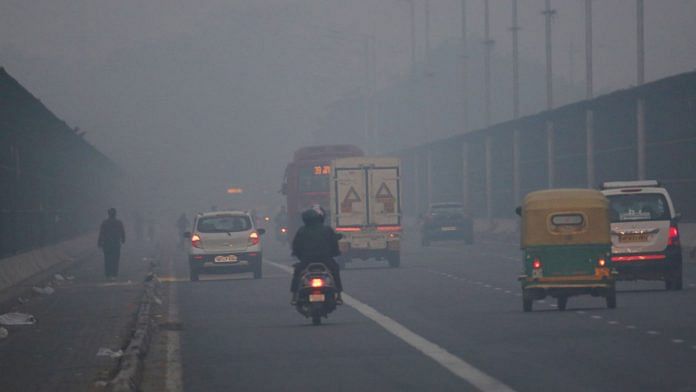New Delhi: India has seen a 10.7 per cent reduction in particulate pollution levels from 2016 to 2018, which translates to an almost one year gain in life expectancy of an average Indian, according to the latest data released by researchers from the University of Chicago.
According to the Air Quality Life Index (AQLI) — the pollution index that measures the impact of particulate air pollution on life expectancy — India was the most polluted country in the world in 2016 with particulate pollution level at 71.7 micrograms per cubic metre.
This level of pollution meant that Indians were losing upto 6.1 years of their lives on average due to air pollution.
The Chicago study published Tuesday revealed that India’s pollution level reduced to 63.0 micrograms per cubic metre in 2018.
The study said that an average Indian would live upto five years longer if the air quality in the country met the World Health Organization (WHO) standard, the researchers said.
The WHO benchmark for particulate pollution level is 10 micrograms per cubic metre.
The report also revealed that India is the second most polluted country after Bangladesh. Nepal, Pakistan and Singapore are among the five most polluted countries.
In 2019, the central government had announced the National Clean Air Programme (NCAP) to reduce the 2017 level of particulate pollution by 20-30 per cent by 2024. In 2017, the particulate pollution level was 66.0 micrograms per cubic metre.
The report stated that achieving a nationwide reduction of 25 per cent would increase India’s national life expectancy by 1.6 years, and by 3.1 years for residents of Delhi.
Residents of Delhi could see more than nine years added to their lives if pollution was reduced to meet the WHO standard, it stated.
Delhi has, however, seen an overall reduction in pollution levels in 2018 by at least 20 per cent, according to the data.
In 2016, air pollution in Delhi was estimated to reduce life expectancy by over 12 years, the report stated.
Also read: How drop in pollution is giving social media users a clearer India to show off
Lucknow has the highest level of pollution
Researchers also pointed out that particulate pollution in India has seen an increase by 42 per cent since 1998.
As much as 84 per cent of Indians live in areas that exceed the country’s own air quality standards, while the entire population is exposed to levels that exceed the WHO standard, they said.
Lucknow has the highest level of pollution in the country at 114.6 — 11 times higher than the WHO standard. Residents of Lucknow stand to lose 10.3 years of life expectancy if pollution persists, according to the report.
“Though the threat of coronavirus is grave and deserves every bit of the attention it is receiving — perhaps more in some places — embracing the seriousness of air pollution with a similar vigor would allow billions of people around the world to lead longer and healthier lives,” Michael Greenstone, one of the authors of the report, from the Energy Policy Institute at the University of Chicago (EPIC) said in a statement.
“The reality is, no shot in the arm will alleviate air pollution. For a country like India, the solution lies in robust public policy. The AQLI tells citizens and policymakers how particulate pollution is affecting them and their communities, and can be used to measure the benefits of policies to reduce pollution,” Greenstone said.
The report also stated China has managed to reduce pollution levels by 39 per cent from 2013 to 2018. According to the report, three quarters of the reduction in world’s particulate pollution stems from China.
“If the reductions are sustained, China’s people can expect to live some two years longer,” the report said.
‘Strong policies can reduce pollution’
The report further said that nearly 230 million residents of Uttar Pradesh are on track to lose more than 8 years of life expectancy if the state doesn’t meet the WHO standard.
In 2016, the residents of the state — with 116.5 micrograms per cubic metre pollution level — were on track to lose 10 years of life expectancy.
The pollution level in 2018 was, however, reduced to 97.3 micrograms per cubic metre. This reduction has increased life expectancy of UP residents by almost two years on an average, the report stated.
The researchers said that state governments in India have already been working proactively towards improving air quality.
“History is full of examples of how strong policies can reduce pollution, lengthening the lives of residents,” said Greenstone.
Also read: To fight India’s airpocalypse, Modi govt must first centralise air pollution policy



